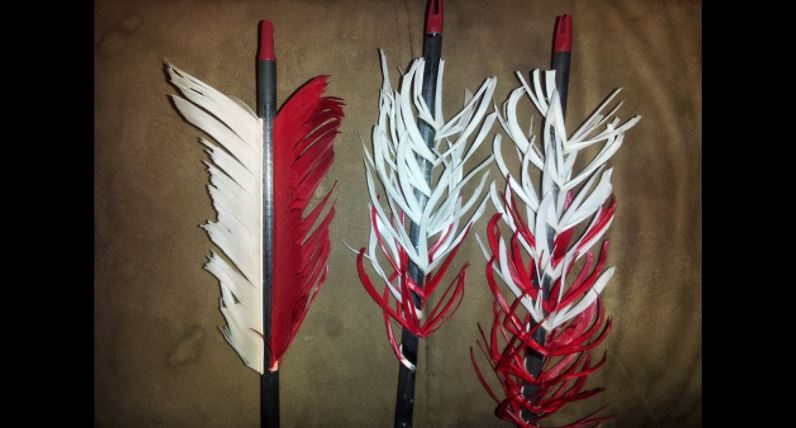A flu flu arrow is designed to travel short distances. It can fly straight for about 30 yards before it starts to slow down and lose direction. You’ll mainly use these arrows to shoot aerial targets or recreational archery, where the arrow should only travel short distances. What’s more, if you miss a target, you won’t have any trouble retrieving your arrow because of the short distance it travels.
Flu flu arrows don’t have sharp tips. Their blunt tips prevent the arrow from sticking into hard services, so you don’t have to worry about your arrows getting stuck in trees if you miss your target.
Here at Archery Edge, we recently published articles on celebrities who love archery as well as benefits of joining an archery club, for those of you who are interested!
Fletching

A flu flu arrow is usually fletched with long sections of feathers. Sometimes, it can also be spiral-wrapped with two feathers around the shaft. The large feathers reduce the arrow’s flight distance, making it a viable option for shooting flying targets. Here is a breakdown of different types of fletching:
Spiral Fletch Arrow
Notoriously known for its rapid stopping power, this arrow has full-length feathers wrapped around the shaft. Instead of one feather, this arrow makes use of two feathers; because of that, it has a relatively short range.
Six-Fletch Arrow
This arrow has twice the range of the spiral fletch. Its feathers are cut shorter to about four to five-and-a-half inches. The feathers are glued to the shaft at an angle that increases the drag as it flies.
Four-Fletch Arrow
This arrow is similar to the six-fletch arrow, except the feathers aren’t trimmed. This arrow doesn’t have as much drag and is best used with light-to-middleweight bows.
Three-Fletch Arrow
This arrow is made with three feathers around the shaft. It is an excellent arrow for lightweight bows because it has minimal stopping power.
What are Flu Flu Arrows Used For?

Flu flu arrows are mostly used for flying or fast-moving targets. Unlike with stationary target shooting, you have to release the arrow to anticipate the target’s flying path. Two popular ways in which archers use flu flu arrows are when hunting birds and squirrels. Here are some other times when you’ll want to use flu flu arrows:
Flying Target Shooting
Foam disks, clay pigeons, and basketballs are excellent targets to shoot out of the air. The only thing you need to make sure of is that your target is airborne and won’t hurt your flu flus.
Wingshooting
Shooting a flying bird out of the sky with a bow and arrow is one of the greatest challenges in archery, and your choice of bow, flu flu, and fletching style is critical to your success.
Remember that you are dealing with livestock and make sure to understand your state’s policies around the shooting of birds before you begin. Except for pigeons, sparrows, and starlings, all birds are protected, and you can face a hefty fine for shooting them without the proper paperwork.
Trick Shooting
This might appeal to more-experienced archers as it requires you to shoot smaller targets in the air. Small items such as tennis balls or paintballs are excellent practice targets. Once again, make sure your targets and the surrounding area won’t damage your flu flus.

Shooting squirrels
The short range of a flu flu arrow makes it safe to shoot up a tree and recover arrows that fall to the ground.
Flu Flu Golf
This is a fun activity for beginner archers. In this game, you must go to the spot where your arrow has landed to shoot it again until you reach the final destination. Although there is not always a specific target until you get to the end, it’s a fun way to test and try different shooting techniques.
Materials Used for Making Flu Flu Arrows

Carbon
Carbon arrows are the most expensive, but their resilience is quite astonishing. Carbon is lightweight and won’t bend easily. When they are broken, the downside of these arrows is that you can’t repair them, but luckily, they don’t break easily.
Aluminum
Aluminum has the benefit of being lightweight and hollow. Aluminum arrows are much cheaper than carbon arrows and are a good option for lightweight bows. Another advantage of these arrows is that you can bend them back into shape, thanks to their flexibility.
Wood
Archers made traditional arrows from wood, and it is still a trustworthy material today. Wooden arrows’ prices range depending on the wood’s quality, and although wooden arrows break easily, they are sometimes repairable.

